Related Research Articles
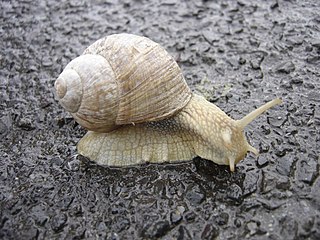
A snail is, in loose terms, a shelled gastropod. The name is most often applied to land snails, terrestrial pulmonate gastropod molluscs. However, the common name snail is also used for most of the members of the molluscan class Gastropoda that have a coiled shell that is large enough for the animal to retract completely into. When the word "snail" is used in this most general sense, it includes not just land snails but also numerous species of sea snails and freshwater snails. Gastropods that naturally lack a shell, or have only an internal shell, are mostly called slugs, and land snails that have only a very small shell are often called semi-slugs.

The gastropods, commonly known as snails and slugs, belong to a large taxonomic class of invertebrates within the phylum Mollusca called Gastropoda.

The grove snail, brown-lipped snail or Lemon snail is a species of air-breathing land snail, a terrestrial pulmonate gastropod mollusc.

Achatinella is a tropical genus of colorful land snails in the monotypic Achatinellidae subfamily Achatinellinae. Species are arboreal pulmonate gastropod mollusks with some species called Oʻahu tree snails or kāhuli in the Hawaiian language.

Terrestrial animals are animals that live predominantly or entirely on land, as compared with aquatic animals, which live predominantly or entirely in the water, or amphibians, which rely on a combination of aquatic and terrestrial habitats. Some groups of insects are terrestrial, such as ants, butterflies, earwigs, cockroaches, grasshoppers and many others, while other groups are partially aquatic, such as mosquitos or dragonflies who pass their larval stages in water.

Euglandina rosea, the rosy wolfsnail or cannibal snail, is a species of medium-sized to large predatory air-breathing land snail, a carnivorous terrestrial pulmonate gastropod mollusk in the family Spiraxidae.

Helicina is a genus of tropical and subtropical land snails with an operculum, terrestrial gastropod mollusks.

Newcombia cumingi, common name Newcomb's Tree snail, is a species of air-breathing land snail, a terrestrial pulmonate gastropod mollusk in the family Achatinellidae. This species is endemic to Hawaii, the United States.
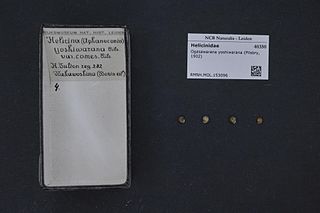
Ogasawarana yoshiwarana is a species of land snail with an operculum, a terrestrial gastropod mollusk in the family Helicinidae, the helicinids.
The flat-spired three-toothed snail —also known as the Cheat three-toothed snail after the Cheat River in West Virginia—is a species of air-breathing land snail, a terrestrial pulmonate gastropod mollusk in the family Polygyridae.

A land snail is any of the numerous species of snail that live on land, as opposed to the sea snails and freshwater snails. Land snail is the common name for terrestrial gastropod mollusks that have shells. However, it is not always easy to say which species are terrestrial, because some are more or less amphibious between land and fresh water, and others are relatively amphibious between land and salt water.
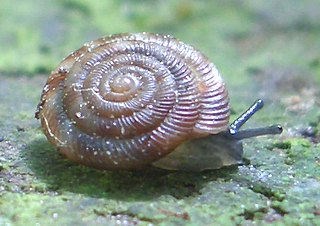
Discus rotundatus, common name rotund disc, is a species of small, air-breathing, land snail, a terrestrial pulmonate gastropod mollusk in the family Discidae, the disk snails.

The reproductive system of gastropods varies greatly from one group to another within this very large and diverse taxonomic class of animals. Their reproductive strategies also vary greatly, see Mating of gastropods.

Quantula striata, also known as Dyakia striata, is a species of medium-sized, air-breathing, tropical land snail. It is a terrestrial, pulmonate, gastropod mollusk in the family Dyakiidae. This species appears to be unique among terrestrial gastropods in that it is bioluminescent: Its eggs glow in the dark, and juveniles and most adults give off flashes of green light. It is the only species in the genus Quantula.

Helicina fasciata is a species of tropical land snail with an operculum, a terrestrial gastropod mollusk in the family Helicinidae.

Helicina platychila is a species of tropical land snail with an operculum, a terrestrial gastropod mollusk in the family Helicinidae.
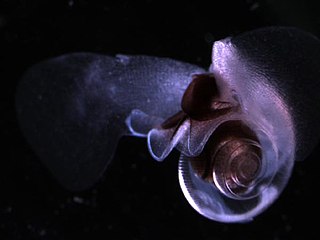
Limacina helicina is a species of small swimming planktonic sea snail in the family Limacinidae, which belong to the group commonly known as sea butterflies (Thecosomata).
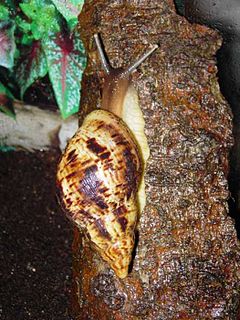
Lissachatina reticulata is a species of air-breathing land snail, a terrestrial pulmonate gastropod mollusc in the family Achatinidae, the giant African snails.

The mating of gastropods is a vast and varied topic, because the taxonomic class Gastropoda is very large and diverse, a group comprising sea snails and sea slugs, freshwater snails and land snails and slugs. Gastropods are second only to the class Insecta in terms of total number of species. Some gastropods have separate sexes, others are hermaphroditic. Some hermaphroditic groups have simultaneous hermaphroditism, whereas some sequential hermaphroditism. In addition, numerous very different mating strategies are used within different taxa.
References
- 1 2 Strenth N. E. & Littleton T. G. (1 February 2000). "A revision of the land snail Helicina orbiculata (gastropoda: prosobranchia) from the southern United States.". The Texas Journal of Science . accessed 3 May 2010
Hailey Hills- amateur malacologist